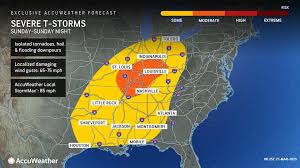A powerful storm system is sweeping across the United States, bringing the threat of destructive tornadoes, flash flooding, and strong winds. Over 100 million people from the Great Lakes down to the Gulf Coast are in the storm’s path, with dangerous conditions expected to continue over the next few days.
The National Weather Service (NWS) has issued multiple warnings, urging residents to stay informed and take necessary precautions. This storm has already left thousands without power, and the situation is only getting worse as it moves eastward.
Tornado Watches Issued Across Multiple States
Severe thunderstorms capable of producing tornadoes have been spotted across several states, including Illinois, Indiana, Michigan, Kentucky, and Missouri. The Storm Prediction Center (SPC) warns that these storms could bring strong winds, large hail, and even violent tornadoes.
As the storm moves toward the East Coast, nearly 92 million people from New York to Louisiana are bracing for more extreme weather. Meteorologists say that the mid-Atlantic and Southeast could be hit particularly hard, with the potential for damaging winds and more tornadoes forming.

Heavy Rainfall Triggers Flash Flood Concerns
In addition to tornadoes, this system is dumping heavy rain across many regions, creating dangerous flash flooding conditions. Low-lying areas and cities with poor drainage systems are especially at risk.
Officials are warning people to stay off the roads if possible, as rapidly rising water can turn highways into rivers within minutes. If you come across a flooded street, turn around—just a few inches of fast-moving water can be enough to sweep a car away.
Impact on the Great Lakes Region
The northern part of this storm system is creating problems of its own. In the Great Lakes region, freezing rain has caused widespread power outages, with Michigan and Wisconsin being hit especially hard. Some areas have reported up to an inch of ice accumulation, bringing down trees and power lines.
Utility companies are working around the clock to restore electricity, but for many residents, it could be days before the lights come back on. In the meantime, warming shelters have been opened to help those affected by the outages.
Southern States Face Tornado and Storm Threats
In the South, the storm is bringing an increased risk of tornadoes. Parts of Texas, including cities like Beaumont, are under a tornado watch, with the worst of the weather expected through the weekend.
Flooding is also a major concern in Louisiana, Mississippi, and Alabama, where heavy rainfall could quickly overwhelm drainage systems. With another round of severe weather expected early next week, residents are being urged to stay prepared and keep an eye on forecasts.
A Deadly March for Severe Weather
This latest storm comes after a devastating tornado outbreak earlier this month, which left at least 43 people dead across eight states. Over 100 tornadoes were reported during that outbreak, highlighting just how dangerous this time of year can be for severe weather.
Spring is peak tornado season for much of the U.S., and with climate conditions fueling more frequent and intense storms, experts warn that this could be just the beginning of a long and dangerous season.
How to Stay Safe During Severe Weather
With storms continuing to develop, it’s crucial to have a plan in place. Here are some key safety tips:
-
Stay Informed – Check local news and weather apps frequently for updates. Tornado warnings can be issued with little notice, so staying aware is critical.
-
Have an Emergency Kit – Stock up on essentials like water, non-perishable food, flashlights, extra batteries, and a first-aid kit.
-
Know Your Safe Place – If a tornado warning is issued, take shelter in a basement or an interior room on the lowest floor of your home. Avoid windows.
-
Don’t Drive Through Floodwaters – If you encounter a flooded road, turn around. Even six inches of water can knock a person off their feet, and a foot of water can carry away a vehicle.
Looking Ahead
Forecasters warn that this storm system is far from over. More severe weather is expected into early next week, meaning millions will remain on high alert.
If you live in an affected area, stay prepared, keep an eye on the forecast, and most importantly—stay safe.


Comments are closed, but trackbacks and pingbacks are open.